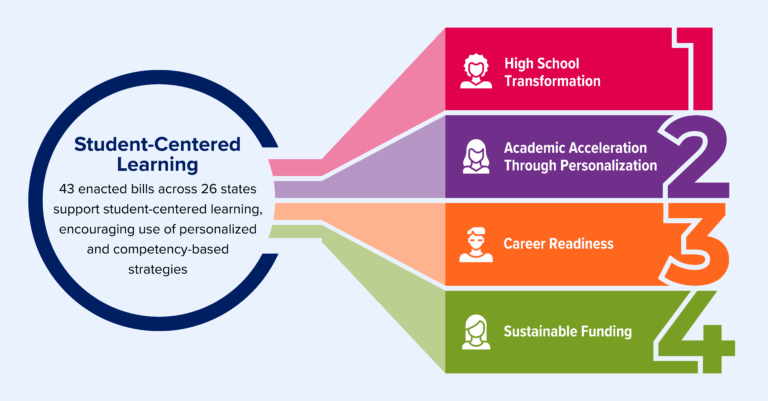As traditional education models continue to show their limitations, a growing number of states are embracing student-centered, competency-based learning as a path forward.
Between the release of our last policy framework to our most recent State Policy Framework for Personalized Learning, we have provided technical assistance to at least 25 states and partnered with leading policy organizations like the Education Commission of the States, the National Conference of State Legislatures, the National Association of State Boards of Education and FullScale. These collaborations have produced tools such as the State of Competency-Based Education Policy Map and a real-time legislative tracking hub, helping states benchmark progress and identify opportunities for innovation.
From pockets of innovation to systems change
One of the most significant takeaways from the past five years is the shift from isolated innovation to broader systems transformation. States are no longer just experimenting with new models—they are embedding them into policy frameworks. Our legislative tracking work suggests that states are increasingly moving away from policies like innovation zones or waivers and are thinking about how to best institutionalize flexibility to adopt personalized, competency-based systems. For example, just in the past year:
- Washington’s Senate Bill 5189 directed the state board of education to develop recommendations for a mastery-based transcript for all public schools, among other things
- Kentucky’s Senate Bill 207 expands flexibility for schools to implement student-centered approaches
- Missouri’s House Bill 2002 increases funding for competency-based education
These legislative moves signal a continued commitment to rethinking how learning is structured and assessed for all students, not just students in a few innovative regions of the state.
Policy is advancing, but implementation lags
Despite the momentum around personalized, competency-based learning, implementation remains a challenge. While policy uptake is high, many states are seeing districts struggle to translate policy flexibilities into practice on a broad scale. This gap underscores the need for targeted support and capacity-building at the district and school levels.
KnowledgeWorks is addressing this in several ways, including integrating policy implementation actions into our core guidance on policy change, providing technical assistance tailored to local contexts and offering thought leadership to help education leaders anticipate what’s next. In Minnesota, for example, we developed the a Strategy Guide for the Association of Metropolitan School Districts to offer guidance for districts looking to create student-centered learning environments. Similarly, the Montana Innovation Guide was crafted to support the success of all K-12 learners in the state. The Kentucky Opportunity Analysis helps ensure that all state systems, especially those impacting assessment and accountability, support and encourage the further growth of such practices statewide.
Policy shifts and future directions in education
Over the past several years, some of the most significant policy changes in education have centered around increased flexibility and personalization. Notably, many states have adopted Portraits of a Graduate, which redefine what students should know and be able to do upon graduation. There has also been a growing trend toward waiving traditional seat-time requirements, offering more flexible course credit options and changes to graduation requirements.
Despite these advancements, certain areas remain particularly challenging to reform. Assessment and accountability systems, for instance, have seen limited progress, largely due to the lack of movement at the federal level. This stagnation has made it difficult for states to innovate in meaningful ways. Funding systems also continue to pose persistent obstacles, with equity and sustainability remaining elusive goals.
Looking ahead, we see several promising opportunities for transformation over the next five years. Artificial intelligence (AI), when pursued in collaboration with educators, has the potential to positively impact learning in and out of the classroom. High school redesign should remain a focus, as data tells us that too many young people aren’t finding value in their K-12 education. There’s also a pressing need to advance skills validation, taking cues from leaders in higher education and pushing for similar momentum in K-12. Finally, we should be prepared to leverage any new federal flexibility to pilot innovative approaches to assessment and accountability, creating space for models that better reflect student learning and growth.
One-size-fits-all no longer cuts it. Now is the time to rethink our education systems and structures, focusing them on student-centered education that prepares students with the knowledge, skills and dispositions needed for success in a changing world.
States play a critical role in creating the conditions for student-centered learning to thrive.








